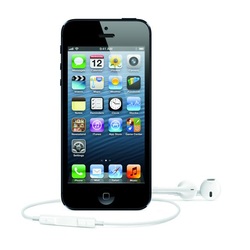
The iPhone 5 is shipped with iOS 6 (released in September 19, 2012). Many of the iPhone 5’ features that work specifically with the included new iOS 6.0 operating system, will only work in certain territories on release. Apple has said this is a rolling program, which will take longer to implement across more regions.
The phone can act as a hotspot, a site that offers Internet access over a wireless local area network through the use of a router connected to a link to an Internet service provider; sharing its internet connection over WiFi, Bluetooth, or USB. It also accesses the Apple App Store, a online/digital application distribution platform for iOS developed and maintained by Apple Inc.--”application software,” also known as an “application” or an “app,” is computer software designed to help the user to perform specific tasks; while “digital distribution” (also called “content delivery,” online distribution,” or “electronic software distribution” (“ESD”), among others) describes the delivery of media content such as audio, video, software and video games, without the use of physical media usually over online delivery mediums, such as the Internet. The service allows users to browse and download mobile applications (“mobile apps”), or software applications designed run on smartphones, tablet computers and other mobile devices, from the iTunes Store, originally the “iTunes Music Store,” a software-based online digital media store operated by Apple Inc., that were developed by Xcode, an Integrated Development Environment (IDE) containing a suite of software development tools developed by Apple for developing software for OS X and iOS; and the iOS SDK (“Software Development Kit”) (formerly “iPhone SDK”), a software development kit developed by Apple Inc, released in February 2008 to develop native applications for iOS.
See: Internet By Satellite Broadband
 RSS Feed
RSS Feed